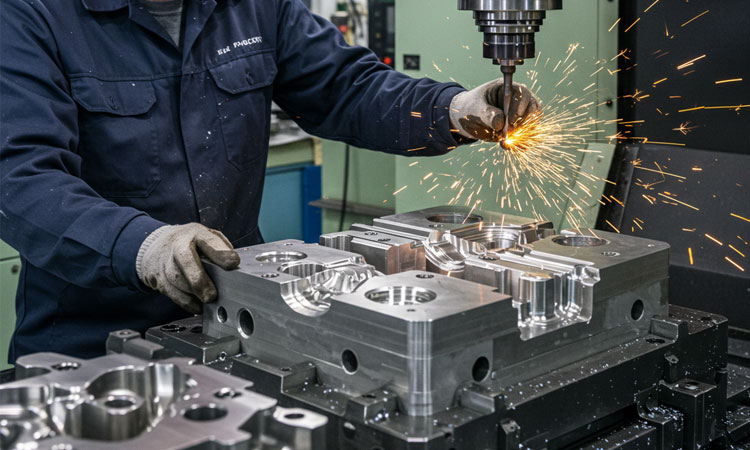The die and mould machining industry, often operating behind the scenes, is undergoing a transformative revolution. Traditionally viewed as a support system for mass manufacturing, it has now become a driving force—reshaping how the world builds everything from cars to smartphones, aerospace components to medical implants. It’s the blueprint creator, the master builder behind intricate components that bring innovation to life. This isn’t merely about cutting metal; it’s about making the impossible, possible.
Precision Unleashed: Micron-Level Mastery Redefines Manufacturing
In the age of hyper-precision, traditional approximations are giving way to digital perfection. Technologies like Computer Numerical Control (CNC) machining, Electrical Discharge Machining (EDM), and high-speed milling are setting new benchmarks in accuracy. We’re now crafting components with tolerances finer than a strand of human hair—essential for sectors like aerospace, medical devices, and automotive safety where failure is not an option.
This level of detail demands more than just mechanical capability; it calls for craftsmanship powered by data and automation. With tool paths optimized by AI and real-time monitoring ensuring flawless execution, die and mould shops are becoming high-tech sanctuaries of precision engineering.
Additive Manufacturing: Breaking the Mould—Literally
3D printing, or additive manufacturing, is rewriting the rulebook. What was once the realm of science fiction—organic shapes, hollow interiors, and lattice structures—is now manufacturable reality. In the world of dies and moulds, this means:
- Rapid prototyping that slashes time-to-market.
- Customization that meets specific client needs without massive retooling.
- Complexity without compromise, allowing the creation of tools and inserts that are lighter, stronger, and more efficient.
Additive technology is especially powerful when hybridized with subtractive methods, enabling manufacturers to produce conformal cooling channels, improve thermal performance, and extend tool life.
Smart Factories: Intelligence at the Heart of Production
Welcome to the era of Industry 4.0—where machines don’t just operate, they think. Integrated with IoT sensors, AI algorithms, and digital twins, today’s machining environments are evolving into smart ecosystems. These systems can:
- Predict maintenance before a breakdown occurs.
- Optimize machining parameters in real-time.
- Reduce downtime by learning from operational history.
Digital twins allow manufacturers to simulate entire operations, test new setups virtually, and fine-tune production flows without halting the real-world line. This convergence of physical and digital systems is enabling mass production with the agility of customization.
Sustainability: Green is the New Gold
Sustainability is no longer a checkbox—it’s the mandate. Global regulations and conscious consumers are demanding environmentally responsible manufacturing. The die and mould industry is responding with:
- Recyclable and low-carbon footprint materials.
- Energy-efficient machining centers with regenerative braking and smart cooling.
- Waste reduction practices, including near-net-shape machining and digital inventory management.
This shift is more than just corporate social responsibility. Green manufacturing opens doors to global markets, reduces long-term operational costs, and strengthens brand equity in an eco-conscious economy.
Virtual Prototyping: Simulate, Then Fabricate
In a world where speed is critical, simulation and modeling tools are proving invaluable. Advanced software enables engineers to test products under extreme conditions—thermal, mechanical, or dynamic—before cutting a single chip. Benefits include:
- Fewer design iterations and physical prototypes.
- Enhanced accuracy in predicting tool wear and performance.
- Reduced risk of failure in critical-use applications.
By validating designs in a virtual environment, companies can make smarter choices early in the design cycle, ultimately producing better moulds, faster and cheaper.
Global Hotspots: Mapping the Innovation Trail
The evolution of die and mould machining is a global phenomenon, with key regions driving innovation in unique ways:
- India: Riding high on a booming automotive and defense manufacturing sector, supported by government initiatives like Make in India. The Indian die and mould market is growing at over 8% annually, with significant investments in automation and capacity expansion.
- China: The world’s largest manufacturing hub, pushing aggressively into smart factory setups and digital tooling. The Chinese die and mould industry is worth over $20 billion and is integrating robotics and AI to maintain dominance.
- Germany: Renowned for its engineering excellence and precision, German companies lead in sustainability, lean manufacturing, and the integration of Industry 4.0 technologies.
- United States: A leader in innovation, particularly in aerospace, medical, and defense sectors. U.S. firms are leveraging additive manufacturing and AI to produce highly customized, mission-critical components.
- Japan: The automation expert. Japanese firms are pioneering ultra-precision moulding and robotic manufacturing lines, essential for electronics, semiconductor, and automotive applications.
The Road Ahead: Smart, Sustainable, and Personalized
What does the future look like for the die and mould machining industry? It’s smart, sustainable, and agile.
- AI-Driven Production: Machining centers will not just execute commands—they’ll make decisions. AI will play a central role in predictive maintenance, dynamic process optimization, and adaptive quality control.
- Eco-Conscious Manufacturing: Regulations will demand carbon neutrality. Companies will invest in green supply chains, recyclable materials, and energy-efficient systems to stay ahead of compliance and win market trust.
- Mass Customization: Flexible manufacturing systems will make one-off and small-batch production as viable as mass production, enabling tailored solutions for niche markets and individual consumers.
- Skilled Workforce Development: The workforce of the future will be digitally fluent. Upskilling programs in AI, data analysis, and hybrid manufacturing technologies will be critical to bridge the skill gap.
Adapt or Become Obsolete
The die and mould industry is undergoing a seismic transformation. The convergence of digital intelligence, environmental consciousness, and advanced manufacturing is setting new standards for what’s possible.
To lead in this new era, companies must embrace change, invest in innovation, and cultivate talent. This is not just about improving productivity—it’s about redefining what manufacturing means in the 21st century.
Those who adapt will shape the future. Those who resist will be left behind. In the quiet corridors of die and mould shops across the globe, a revolution is underway—and its precision-crafted impact will define industries for decades to come.



